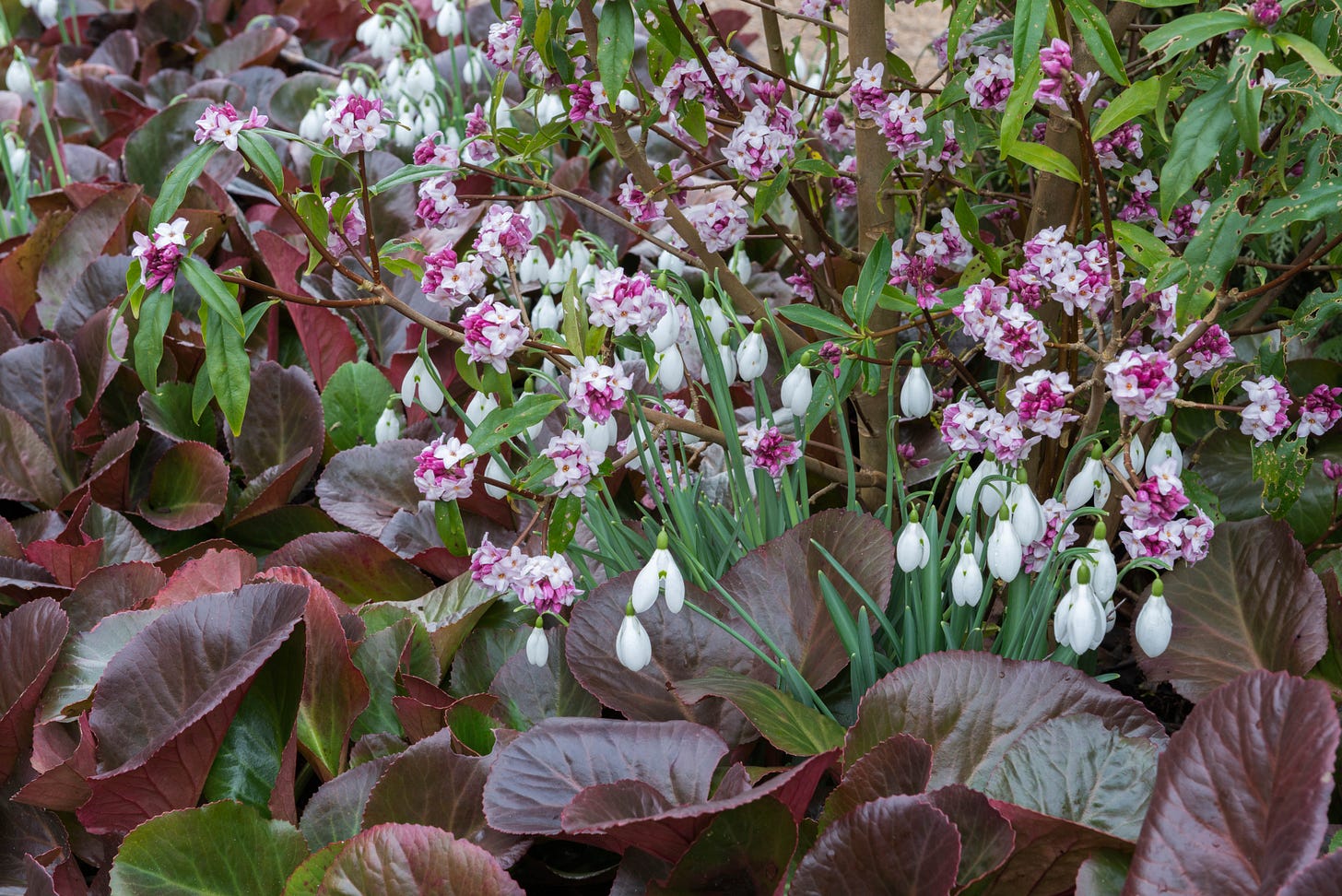How to design show gardens and small gardens
Plus: a plant for the winter garden, with planting combination ideas
(This post will be truncated in emails so please click ‘view entire message’ or head to your browser/app to read the full version there)
Spring seduced me with tulips, summer distracted me with roses, and autumn fooled me with winter grasses.
Well, what’s the temperature like where you are?
It’s pretty chilly here, with morning temperatures down to -5°C, and my clay soil has basically turned to rock, not the most welcoming of surfaces to dig into. And so it is that this year too, the remaining tulip bulbs are going to be scattered on top of the ground with compost on top of them, in my usual late January style. If you’ve decided to stay indoors for the duration, browsing through the seed and bulb catalogues, remember that there are plenty of summer bulbs ideas here on The Gardening Mind.
In our online chat this week, many of you mentioned that you’re busy planning changes to your plots, as getting on with your garden design tweaks and plans is an excellent cold-weather job, so I’m delighted to let you know that by popular demand, the Small Garden Design Course is back!
I’m going to be once more sharing hints and tips and tricks and thoughts gathered over my nearly 30 years in the business, starting off at the very beginning of the process of how to go about designing a small space. It may be the whole of your garden that you want to take a look at, or just a smaller area of your garden: it’s totally up to you.
It won’t be too technical, and I think we’re going to have a lot of fun. You can either simply observe, or if you want to join in, all you’ll need is a notepad, something to scribble with, and a large mug of tea or coffee. And maybe a biscuit or two. That’s it. This course is for everyone - new and old members alike, so whether you started last year and want to share your progress, or whether you’ve just joined TGM recently and would love to know how to go about designing your small garden (or large - the things we discuss apply to gardens of all sizes), this new series will take place on Chat and the occasional Zoom. Don’t panic if you’re not sure what Chat is, as I’ll be talking you through how to navigate it. So look out for this in February.
On the subject of zooms, there are two coming up soon, so do make sure they’re in your diaries: next Wednesday 23rd January 6pm UK (the invitation to this is at the end of this post) I’m going to be showing you images of the completed show garden drawings, and on Monday 29th January 7pm UK, I’ll be taking you on a tour around the Gardening Mind so that you know where to find everything. And there’s always this guide if you’re wondering where to find things in the meantime.


Despite the cold, I really do want to get out and finish the pruning:
this can be a lovely garden job when the sky is blue and bright and the sunsets set the sky alight. But pruning doesn’t involve enough moving around to keep warm, and so it will have to wait whilst I turn my mind to how I can improve the planting’s winter structure for next year.
It’s kind of ok. Currently, the garden is being carried through winter with the structure created by some tall Pittosporum tenuifolium ‘Silver Queen’, along with the white stems of Betula utilis subsp. jacquemontii and the flaming balayage orange-to-red stems of Cornus sanguinea ‘Midwinter Fire.’
But there’s something missing.
The issue is at ground level. It’s crying out for some more interest, something FUN, and I absolutely know what I should have done. I’d had such good intentions when I wrote last year about the love-it-or-loathe-it bergenia, but as with many good intentions, the actual planting of it never quite happened. Spring seduced me with tulips, summer distracted me with roses, and autumn fooled me with winter grasses. No need for any more winter structure, I’d told myself: the garden will get by without it.
But the fact is right now, back in winter again, it’s me and not my garden, who’s disappointed. If I’d got on with planting the bergenia when I said I would, I could now be enjoying the russets and bronzes and greens of these easy plants which have somehow become unfashionable. So this year, I’m vowed to plant some when I can actually dig a hole – and I’ve come up with an easy recipe for a bergenia winter planting which you can find later in this post.
But before I share that with you, I’m going to take you out of the world of plants for a moment, and take you instead on a dive into the show garden design whose progress I committed to sharing with you. And when I say progress, I don’t just mean the finished plans, but the whole grisly lot, from writer’s block, through lightbulb moments, to the finished design….
But first, what even is a show garden. What is the point of them? Where are they found?
Something new, something which had never been done before. We looked at shapes, we discussed possibilities and we leafed through precedent images, all with the intention of creating something different. What we were all keen on was the idea of Nature as part of the built environment, instead of making way for the built environment. Trees as housemates.
There’s a whole world of garden and flower shows out there – you may have heard of the RHS Chelsea Flower Show, but there are many others. Most of these temporary shows last a week or so, such as the RHS shows, and shows in Melbourne and China. Some take place inside big convention centres, eg Northwest Flower and Garden Show1 in Seattle and Philadelphia. Some last for months, eg Chaumont, and some for years,. I’ve been to flower shows in St Petersburg, Japan and Dubai and they are all extraordinary in their different ways. If you’d like a taster of what it’s like to physically build these gardens, head to the Show Garden section on The Gardening Mind.
At these shows, designers create gardens full of ideas both old and new, with the aim of inspiring, encouraging, and generally making the visitor feel happy. These gardens can be small plots, sometimes they can be huge, and after three weeks of building, they are opened to the public and to the judges, for everyone to have their say. This sometimes seemingly-impossible task of creating a truly realistic garden is a labour of love for sure, and every time you do it, you swear you’ll never do it again. These gardens take months, years even, to design and plan.
If you’ve read last week’s column, you’ll know that I’ve committed to designing one of these gardens in the space of two weeks. The Shenzhen Flower Show got in touch and asked if JTLGD2 would like to particpate, In the same moment, my brain said No and my mouth said Yes. How does that happen?
So what ideas did I have at that point in time when I clearly wasn’t in full charge of my mind? I was going to post a photo of a blank piece of paper, but I decided that you’re perfectly able to imagine that for yourselves. That’s what I started off with. I did have some colours and materials in mind because of that sumptuous Top 100 romantic plants palette, and I had the seed of an idea from a previous garden, as shown in the moodboard we looked at last time.
This idea had been percolating the back of my brain since a garden at RHS Chatsworth, where I created a 100m long sculpture which wound its way along and cantilevered out over the River Derwent. I’d then expanded on this in 2018 at RHS Chelsea, where we created a ‘Swallowtail’ pavilion. Since then I’ve longed to develop this idea of the transparent pavilion, using new technology and creating something that would sit as a sculpture as the main event in a garden space.
But that’s just all words
Now come the questions, the niggles, the doubts. How to even start? And it’s all very well having these ideas, but who will build it? Who will make sure that it works – in the sense that it stays up and definitely doesn’t fall down? And as the designer doesn’t even get to attend the build phase of this show, how on earth do we convey the ideas to the builders? Drawings are all very well, but wouldn’t it be good to have something more, that very special something?
But most importantly of all for a show garden is the magic - what will make this stand apart?
This was my first lightbulb moment and I’ll be talking about this in next week’s Zoom. Let’s rewind four months back to September 2023:
In the garden of a palazzo in Venice, just off a busy shopping street, I was being shown the most extraordinary self-supporting vaulted structure. Graceful curves and a swoop of a sculpture brought the 15th and 21st centuries together in a feat of novel technology. I was lucky enough to be introduced to Sigrid Adriaenssens of the Form Finding Lab, the engineers and designers of this very special project at the Venice Architecture Biennale.
And back to the present:
This meeting, back in September, turned out to be my starting point for something very special, very exciting, and completely terrifying as it’s never been done before:





